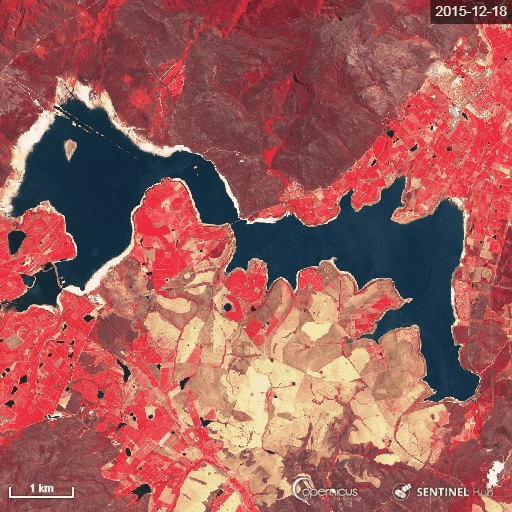Making Sense of the Drought Situation in Cape Town
Published on by Water Network Research, Official research team of The Water Network in Technology
The JRC, with data from its Global Drought Observatory (GDO), provides analytical reports on the crisis as it develops.
Cape Town has come dangerously close to running out of water after 3 years of persistent drought.
Tight water usage restrictions have been successful in stalling 'day zero' - when the city's taps will be turned off—until 2019, buying time for authorities to look for more ways to manage the crisis.

These images clearly show the decreasing water level of the Theewaterskloof Dam near Cape Town. The time lapse was created with false colour composites of the EU’s Copernicus and Sentinel-Hub satellite imagery from December 2015 to May 2018. Credit: CORDIS
The JRC, with data from its Global Drought Observatory (GDO), provides analytical reports on the crisis as it develops.
Rainfall levels in April, May and June, during the wettest period of the year, can give some indication as to the likelihood and timescale for recovery.
But the roots of the current situation run much deeper. A new JRC technical report has found that the massive water shortage, while exceptional, is characteristic of longer-term weather patterns.
With climate change spurring more and more extreme weather events, severe shortages could become an increasingly regular occurrence in the future.
Water shortage and rising temperatures
JRC scientists looked at precipitation in Southern Africa over the past 36 years and found that there exists a strong probability of 50-70 percent monthly precipitation deficit every 5 years (more moisture lost through evaporation and transpiration than is gained through rainfall).
In the Western Cape, the deficit could reach as high as 70-80 percent every 10 years.
The scientists also analysed the occurrence of warm weather events in the region over the same period.
They found an increasing number of moderate to extreme heatwaves in Southern Africa over the last decade.
These two factors combined – the repeated occurrence of high precipitation deficit and more frequent heatwaves – exacerbate water shortages and could lead to more frequent crises in the future.
And with Cape Town's 4 million inhabitants expected to grow by 5 percent over the next 5 years, the demand for water will only increase.
Media
Taxonomy
- Drinking Water Security
- Drinking Water Treatment
- Resource Management
- Water Resource Management
- GIS & Remote Sensing Technology
- GIS
- Drought
- Drinking Water Managment
- Drinking Water
- Water Resource Management
- GIS Spatial Analysis
4 Comments
-
The conclusion of a warmer and drier Western Cape, especially for the western half of this region is not new news. This has been well modelled, documented and understood for some time (refere to http://www.csag.uct.ac.za/) . The planning strategies have taken the need for diversity of supply into account with steps for reuse and groundwater and lastly desalination. The extent of the drought did catch the relevant authorities off-guard, but the focus is now on medium to long term responses following the short term reaction to the drought.
-
Even without the present man-made contribution to climate change, the climate will change in future as it has done for the past 3,000 million years. For Southern Africa a long (100-s of years) dry period is predicted. Concentrate on things which people can actually control: Reduce water losses from the distribution system (presently over 30 %); make users eliminate waste and reduce water consumption (don't let taps run; apply strongly progressive tariffs); recycle waste water; aim for efficient water use in agriculture (irrigation technology, choice of crops); invest in desalination techniques and systems. Nothing of this is new or novel; much can be done (maybe unglamorous and unspectacular). Thinking about climate change is very interesting and exiting, but does not provide the solutions the local people need now.
-
There are decentralised, desalination solutions, that are modular, quick to install, and quick to add on if more water is needed due to unexpected longer droughts. Solutions touted include the Fluence's Nirobox for example. Appreciate thoughts why such solutions are not workable or adopted in South Africa.
-
There are 2 choices. Worry about a fictious global agenda or "work the problem at hand "! 1. If the problem is because of a "Centralized" resource system, DECENTRALIZE at once to get the ball rolling. 2. all factors that lead to the current situation of waste be halted. 3. There is more water available then the locals could ever use in a lifetime, teach (and assist) rain water collection, use, reuse. Complaining about any problem and hyping it for profit will not get the job done. This is the part where you avoid condemning the facts and go back and do the math yourself. Q1.How much annual rainfall, Q2.how much used per person average, Q3 measure the square feet of the roof of each home/building.... Now do the math, compare to per person use, This is a short term solution. long term is to teach recycling of all resources. "HOW DO YOU and WHAT IF" questions are welcome. Agenda driven comments are not.